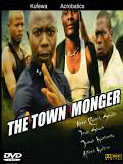When young Malawians made The Town Monger, an independently-produced African Kung Fu film, it used Kung Fu to say something significant about their own lives, community, and the challenges they face in their country.
Walk the vendor-lined streets of Lilongwe, Malawi’s capital city, and you will find a rack of bootleg DVDs with cheaply printed covers. Countless copies of Bruce Lee’s Enter The Dragon, Jack Chan’s Rush Hour or The Medallion, and more contemporary Kung Fu movies such as The Raid exist here.
Even here in southern Africa, there are eager audiences who gleefully mimic the “Hiya!” karate-chops and Crane-style Shaolin stances that have become ingrained images in popular culture around the world. But beyond African kids imitating Bruce Lee’s gestures on the playground, the Kung Fu film genre has also become a meaningful form of cultural expression.
The Cultural Lineage of Kung Fu Movies
In the 1960 and early 70s the Kung Fu movies that were an established mainstay of Hong Kong’s cinema circuit were only just becoming popular amongst an international audience. While English-dubbed Shaw Brothers or Golden Harvest films engendered a big B-movie fanbase in the USA, it was Bruce Lee’s first successful feature The Big Boss that truly opened the world to Kung Fu movies in 1971.
As an international superstar, Bruce Lee was instrumental in creating a global audience for Kung Fu both as a cultural product and as a martial art. However, in the 1990s and early 2000s, mainstream audiences became enamored with Jet Li and Jackie Chan.
It allowed Kung Fu to reach all cultures of the world through the Hollywood pipeline.
These movies that spurred four school-dropouts to incorporate martial arts into their acrobatic street routine. They called themselves Kufewa Acrobatics.
Abdul Rashid Shaibu told an interviewer from Voice of America News: “At first, we were performing around our neighborhood. After the positive response, we started performing in townships, performing in the streets. In the process, people would give us money for each performance".
With their new stage-fight acrobatics incorporating the comedic and theatrical flourishes of Jackie Chan so successful, the group decided to create their own locally-produced Kung Fu movie.
The Town Monger
Is not close to the polished production of Shanghai Noon standards. Due to their minimal budget and lack of resources (filming on a borrowed camera and iPad), the resulting 82-minute long action-flick has more of the aesthetics of 1970's B-movie staples.
When watching clips from their film, it is clear that there is something rich and original unfolding. The localized setting transforms the genre tropes into something strangely exciting, while the acrobatic choreography and expressive movements of Kufewa Acrobatics pulse with purposive energy and intention. There is something more than just action-flick entertainment happening with these young men.
Making Meaning from Kung Fu Movies
The Town Monger is set in the capital city of Malawi and tells the tale of a group of martial artists who notice that street-children in Lilongwe are being corralled and coaxed into crime syndicates by local gangsters. It is then the “Kufewa Acrobats take the kids out of the streets and enrolled them into schools and into their martial arts program.” But, soon after, the local gangsters come looking for their wards and end up in a classic Kung Fu clash with the Kufewa Acrobats.
Using their hometown, the story is uniquely Malawian and meaningful. The film “is based on a real-life story of Kufewa Acrobatics,” according to the group. The film is not just about how proactive citizens can contribute to their community, but it is in itself such a contribution.
In the movie, you can see the local children who have been learning acrobatic Kung Fu from Kufewa Acrobatics. The Town Monger could have been about the making of the movie and how it benefits the kids.
The Town Monger is an action movie. The dialogue is sparse as physical feats, and fight-scenes carry the plot. There are discrepancies. The widely-spread fingers at the end of their Jit Kwon Do posturing arms makes it is clear that the Kufewa Acrobats are not formally trained fighters.
The film says more about what the idea of Kung Fu is than about Kung Fu as martial arts. As the filmmakers told Malawi’s The Times: “Acrobatics is our key area, and we use this as part of the entertainment, and this has taken us to festivals where we have shared the stage with different acts.
But martial arts is used for self-defense, and this is why we came up with the movie.” In Kung Fu movies, martial arts is rarely used solely for personal defense.
It usually forms part of a plot where righteous or redeemed heroes need to defend their friends, their families, or their communities from insurmountable evil. The idea of Kung Fu outlined in movies is it is a transformative tool of moral righteousness, a means of self-improvement, and actualization through which anything can be achieved despite the odds.
The stories told in Kung Fu movies becomes the story of Kufewa Acrobatics itself. For at the end of the day, The Town Monger is a true story of how Kung Fu movies have helped a group of young Malawians to contribute to their community.
And through their practiced skills, their Chan-eque showmanship, and the thrilling stage-fights also make something meaningful of themselves. You’ll find the Kufewa Acrobats traveling through Africa, and their hometown of Lilongwe, Malawi. More videos and sneak peeks can be found on their Facebook page.

